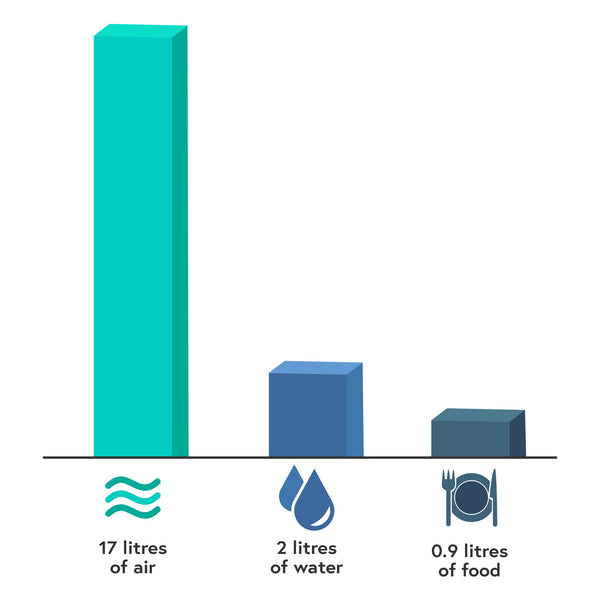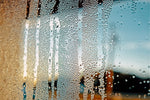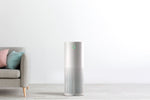Monitoring Air Quality: Volatile Organic Compounds

Written by Brittany German
"What's in the Air?" An Anecdote from Jaspr's Founder
A few days ago, while I was doing some work at the dining table, I noticed a strong chemical odour, so I got up to investigate. Our nanny was washing the windows. It was obvious that was the source of the odours. She was using a brand called Method.

My next step was to run over and check my air quality sensors to see if there was a Volatile Organic Compound (VOC) spike in the air. Sure enough, there was, a huge spike. The crazy thing is, the air sensor is about 70 feet away from the window that was being cleaned.

The sensor data shows the VOCs spike from around 50ppb to over 850ppb in a matter of minutes.
Parts Per Billion (PPB): The concentration of particles in the air.
That is a 17 time increase of airborne chemicals that I do not want my baby daughter breathing. Fortunately, I have a house that is geeked out with air quality monitors and purifiers so when things like this happen, I am quickly aware, and have technology in place that is always adapting to my environment to keep my family safe.
What are Volatile Organic Compounds?
Volatile Organic Compounds (VOCs) are released as gases from many solids and liquids. Concentrations of many VOCs can be 10 times higher indoors which is a problem since we spend up to 90% of our time indoors and that's before Covid-19. What we might think is natural and healthy - because it is classified as "plant-based" - can still be harmful to our health. Being plant-based has good aspects to it, but it's only a comment on the origins of the chemicals. The end chemicals are still the chemical equivalent of ingredients from other non-plant-based sources.
The problem is established. We're spending the majority of our time breathing in significant amounts of poor quality air. To take action and purify our air, we must first understand exactly where these Volatile Organic Compounds are coming from.
Outdoor Volatile Organic Compounds
Outdoor Volatile Organic Compounds can be a hazard since they have the potential to slip indoors. Major sources for outdoor VOCs are as follows:
- The oil and gas industry
- Traffic emissions
- Oil and gas extraction and processing
- Industrial emissions
- Background and biogenic emissions
Indoor Volatile Organic Compounds
Indoor Volatile Organic Compounds are a much bigger problem than those that come from the outdoors because while outdoor VOCs can creep inside, 70% of indoor VOCs come from what's inside.
Building materials
These can be materials you might use to build, finish, or decorate your home. Some examples include paint, sealants, adhesives, flooring, carpet, and pressed wood products.
Home and personal care products
These include all the things we love using to make our house a home like furniture, cleaners, cosmetics, deodorant, and air fresheners.
Activities
These are common things we might do throughout the day and use often like tobacco smoke, dry-cleaned clothing, arts and crafts products, wood burning stoves, and printers.
The Chemicals
Many products and materials we use might seem harmless and might even be portrayed as such (more on that later) but they are actually filled or preserved with chemicals.
The chemicals that are harmful when expelled are:
What Scent Tells Us
Sometimes it can be easy to tell if you're breathing in VOCs because it will have a smell. The smell can be good or bad. Scent itself is normally an indicator that you're breathing in harmful chemicals. However, VOCs can also be scentless so don't rely on scents to peg VOCs around you.
VOCs Stick Around
Just because you don't smell the chemical anymore, or you used that cleaner or printer a couple hours ago, doesn't mean Volatile Organic Compounds have left the air yet. Depending on the activity, not only are VOC levels higher than normal, but those levels of harmful air can linger long after the activity has been completed.
Poor Indoor Air Quality Symptoms
Symptoms that appear from the inhalation of Volatile Organic Compounds can be divided into two categories: immediate symptoms and long term exposure.
Immediate Symptoms
Immediate symptoms, as the category suggests, happen right away. These are the symptoms that you might start experiencing if someone is cleaning nearby, or if you're adding in a new carpet, for example. You might experience:
- Eye, nose, and throat irritation,
- Headaches,
- Loss of coordination,
- Nausea,
- Conjunctival irritation,
- Dyspnea,
- Fatigue,
- Allergic skin reaction,
- Vomiting, and
- Nose bleed.
Long Term Exposure
While less likely, long term exposure happens after prolonged periods of time breathing in the same harmful chemicals. This might seem like a far-off situation, but know that long term exposure can have serious affects on your health, like:
- Damage to liver,
- Damage to kidney,
- Damage to central nervous system, and
- Cancer.
What is in a Product?
Most products will contain colorants to make the colour pleasing, surfactants to help with cleaning, and fragrance to make an appealing scent, or to cover up unappealing scents.

Colorant
Colorant in products indicates the presence of chemicals. On the mild side, these are synthetic or natural additives that add to or change the colour of a product. While colorant additives can come from natural materials, when aerosolized, we still don't want to be breathing those chemicals.
Surfactant
The name comes from the term "surface active agent". They are powerful cleaning agents added to cleaning products to help with wetting surfaces and cutting through grime. Since surfactants are found in so many daily products - toothpaste, cleaning supplies, body wash, paint - you are likely coming in contact with them more than you think and breathing their chemicals in when they get into the air. Think about that the next time you spritz a cleaning product.
Fragrance
Fragrance is not just one ingredient. Fragrance is the term brands use on their labels to encompass a wide variety of chemicals that, put together, smell great and make the product more appealing. These blends of ingredients can contribute to allergies, sensitization, endocrine disruption, negative environmental impact, and cancer.
This chemical stew has many disguises: perfume, fragrance, aroma, and essential oil blend. In all of these euphemisms, there are mixtures of chemicals that develop unique scents and these chemicals are not always safe, but they are chemicals we use on our skin, in our bodies, around the house, and chemicals that enter the air we breathe when sprayed or aerosolized.
These chemicals have a range of negative health effects including cancer, reproductive toxicity, allergies, and sensitivities. A survey showed that 99.1% of participants reported further health effects like migraines, asthma, gastrointestinal problems, and cardiovascular problems. The chemicals in fragrances are especially risky for pregnant women.

Most fragrances contain around 14 chemicals that aren't shared with the consumer and 80% of chemicals that aren't tested for human safety. Look into what chemicals make up your daily products and cosmetics. Shoot for products with informative labels, and products that use essential oils and herbs. If you aren't sure about a product, you can always run a quick search to determine its safety.
Greenwashing Companies
Hidden chemicals are bad enough but Greenwashing companies are worse. Greenwashing is the term used when a company has the tendency to convince consumers that they are more "green" or "environmentally friendly" than they really are.
It's easy for brands to seem more green and natural than they are simply by using certain colours, brand images, commercials, or sayings.
The Method Brand
The Method brand is an example of a Greenwashing company. They sell cleaning supplies like soaps, detergents, and surface cleaners. Their branding is very environmentally focused. They claim to be natural and green from their brand messaging to the images they use but that's where the "natural" and "green" stops. Their products don't follow suit.
Their products have a better environmental profile in the sourcing of their ingredients and in what happens to them after use, but just because it is plant-derived doesn't mean it's healthier for human exposure. The original ingredient may come from a plant, and maybe that reduces the demand for oil-based chemicals, but in the end it is converted into a particular form which is agnostic of its origins.
Some fragrance ingredients in the Method cleaning supplies are:
- Acetate C6 Hexylic,
- Agrumex,
- Aphermate,
- Dihydro Myrcenol,
- Galaxolide,
- Hexyl Cinnamic Aldehyde,
- Hexyl Propionate, and
- Peach Pure.
Some surfactants are:
- Decyl Glucoside,
- Lauryl Glucoside, and
- C12-16 Pareth-7.
These are not natural chemicals and they are not necessarily safe either. They send harmful contaminants into the air and into our skin. The Method Brand is not nearly as natural as they might seem. While they never make any claims to be a natural product, they certainly convey this in their branding.
This is a good example of how we need to take extra steps to consider our health. Some brands more than others might be focused more on selling product rather than educating their customers or providing a safer environment for them. Some brands might think they are a natural option being plant-based because they might not know plant-based products can still release chemicals. Education is key. Look behind the branding.
Monitoring Indoor Air Quality
Monitoring indoor air quality is a necessity and just as important as managing the food and water we intake. But it's so much easier to monitor our food and water, how do we monitor our air when it isn't something that's implemented already?

Next Steps for Clean Air
There are lots of options to ensure you are breathing clean air.
- Increase ventilation by opening windows and creating a breeze
- Read and follow product label instructions (after having read the ingredients)
- Don't store opened containers of used paints or varnishes
- Buy products sparingly if you know you won't use all of it
- Seal materials that can release formaldehyde (pressed wood)
- Don't mix products unless directed to do so on the label
- Use pest management techniques to reduce the need for pesticides
- Check out the Household Products Database to learn more about what’s in common household items
- Look into air purifiers for homes for a hands-off solution
Be Air Aware
Know what you're breathing and take action to benefit your health, the health of your business, customers, patients, or the health of your family. Mike Feldstein (founder) says, "Whether it's from cooking, cleaning chemicals, hairsprays, pet dander, pollution, gas from the stove or even the neighbor's construction project, there are a lot of pollutants that we can't necessarily see or smell, but they are there, and they are harmful."
Our goal is to educate and provide solutions for cleaner air. First, we need to start with awareness. We've barely thought about air before the last couple of years but we wouldn't dare go to a dirty water source to drink. What makes clean air so different?
Our bodies absorb through drinking, eating and breathing. Every day we eat 0.9 litres of food, we drink 2 litres of water, and we breathe up to 17,000 litres of air per day. What is our biggest intake? Air. Where are we lacking in purification? Air.

If you care about putting healthy food and water in your body, you should consider what's in the air you breathe.
The moral of Mike's story is to be air aware. Consider your environment and what chemicals might be lurking in the background. Do your due diligence to determine what is making your air quality poor, and take action to ensure it gets better for you. Read labels. Do research. Consider your options.
Back to Blog


